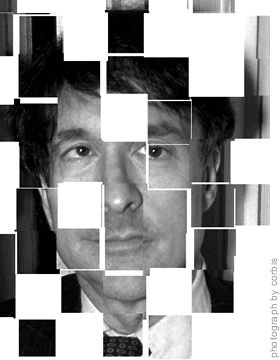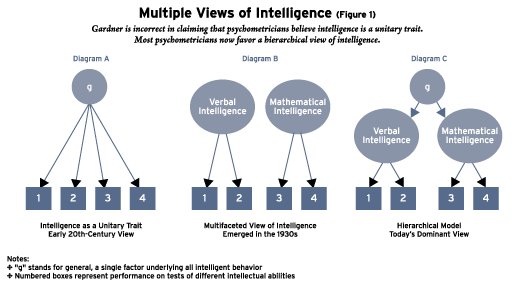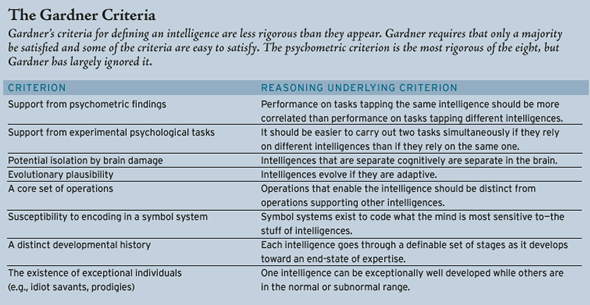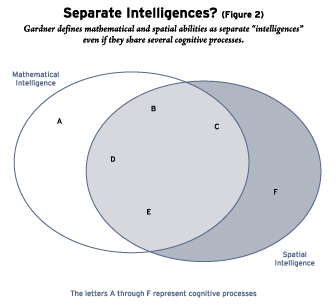 Frames of Mind: The Theory of Multiple Intelligences
Frames of Mind: The Theory of Multiple Intelligences
(Basic Books, 1983)
Multiple Intelligences: The Theory into Practice
(Basic Books, 1993)
Intelligence Reframed: Multiple Intelligences for the 21st Century
(Basic Books, 1999)
By Howard Gardner
Checked by Daniel T. Willingham
What would you think if your child came home from school and reported that the language-arts lesson of the day included using twigs and leaves to spell words? The typical parent might react with curiosity tinged with suspicion: Is working with twigs and leaves supposed to help my child learn to spell? Yes, according to Thomas Armstrong, author of Multiple Intelligences in the Classroom, especially if your child is high in “naturalist” intelligence–one of eight distinct intelligences that Harvard University scholar Howard Gardner claims to have identified. However, if your child possesses a high degree of what Gardner terms “bodily-kinesthetic” intelligence, Armstrong suggests associating movement with spelling. For example, a teacher might try to connect sitting with consonants and standing with vowels.
Armstrong is far from alone in placing faith in Gardner’s theory of “multiple intelligences.” Gardner’s ideas have been a significant force in education for the past 20 years–significant enough that they bear close study. How does the scientific community regard the theory of multiple intelligences, and what impact should the theory have on education?
Central Claims
Gardner first proposed his theory in 1983. Since then, it has undergone incremental but not fundamental change, including the addition of one intelligence (bringing the total to eight), the rejection of others, and consideration of the theory’s applications. The theory rests on three core claims:
• Gardner says that most psychometricians, those who devise and interpret tests as a way of probing the nature of intelligence, conceive of intelligence as unitary. In Intelligence Reframed, Gardner’s most recent restatement of his general theory, he writes, “In the ongoing debate among psychologists about this issue, the psychometric majority favors a general intelligence perspective.”
This is not an accurate characterization of the position taken by most psychometricians. As will be shown, the vast majority regard intelligence not as a single unified entity, but as a multifaceted phenomenon with a hierarchical structure.
• There are multiple, independent intelligences. There are three parts to this claim, and it is important to appreciate all three. First, Gardner offers a new definition of intelligence, describing it as “a biopsychological potential to process information that can be activated in a cultural setting to solve problems or create products that are of value in a culture.” Previous definitions were limited to cognition or thought; one was intelligent to the extent that one could solve problems and adapt effectively to one’s environment using thinking skills. Gardner self-consciously broadens the definition to include effective use of the body and thinking skills relevant to the social world. He also extends the functionality of intelligence to include the crafting of useful products, not just the solving of problems. Second, Gardner claims to have identified some (but not all) of the several types of intelligence, which I describe below. Third, he claims that these multiple intelligences operate independently of one another.
• The multiple intelligences theory has applications to education. Gardner has been careful to say that he has proposed a scientific theory that should not be mistaken for a prescription for schooling. He makes clear that the educational implications of children’s possessing multiple intelligences can and should be drawn, but he believes that many possible curricula and methods could be consistent with the theory. The sole general implication he supports is that children’s minds are different, and an education system should take account of those differences, a point developed in diverse ways by his many followers.
One Intelligence or Many?
Let’s evaluate each of Gardner’s claims in turn, beginning with how psychometricians view intelligence. In the early 20th century, many psychometricians did in fact think of intelligence as a unitary trait, just as Gardner now claims. The thinking at that time was articulated by Charles Spearman, who suggested that a single factor (he called it g, for general) underlay all intelligent behavior. If you had a lot of g, you were smart; if you didn’t, you weren’t. However, by the 1930s some researchers (notably Louis L. Thurstone) were already arguing for a multifaceted view of intelligence. One might be intelligent in the use of words, for example, but unintelligent mathematically. From the 1950s on, many psychometricians proposed hierarchical models, which may be thought of as a mixture of the single-factor and multiple-factor models. Except for a few holdouts, most psychologists now favor the hierarchical model.
How can one use data from tests of cognitive ability to evaluate the number of intelligences? A straightforward approach entails administering a number of separate tests thought to rely on different hypothesized intelligences. Suppose tests 1 and 2 are different tests of verbal ability (for example, vocabulary and spelling), and tests 3 and 4 are different tests of mathematical ability. If there is one intelligence, g, then g should support performance on all four tests, as shown in diagram A of Figure 1 (this page). A high score on test 1 would indicate that the test-taker is high in g, and he or she should perform well on all of the other tests.

Suppose, however, that there are two intelligences–one verbal and one mathematical, as shown in diagram B of Figure 1. In that case, a high score on test 1 would predict a high score on test 2, but would tell us nothing about the individual’s performance on the math tests, 3 and 4. Performance on those tests would depend on mathematical intelligence, which is separate and independent of verbal intelligence.
The data support neither of these views. To continue with our hypothetical example, the data show that all of the test scores, 1 through 4, are somewhat related to one another, which is consistent with the existence of g. But scores from tests of math ability are more related to one another than they are to verbal scores; the same goes for verbal scores. A hierarchical model, shown in diagram C of Figure 1, fits this pattern. In this model, g influences both mathematical and verbal cognitive processes, so performance on math and verbal tests will be somewhat related. But mathematical competence is supported not just by g, but by the efficacy of a mathematical intelligence that is separate and independent of a verbal intelligence. That’s why math scores are more related to each other than they are to verbal scores. It also explains how it is possible for someone to be quite good in math, but just mediocre verbally. This logic applies not only to the restricted example used here (math and verbal) but also to a broad spectrum of tests of intellectual ability.
The hierarchical view of intelligence received a strong boost from a landmark review of the published data collected over the course of 60 years from some 130,000 people around the world. That massive review, performed by the late University of North Carolina scholar John Carroll, concluded that the hierarchical view best fits the data. Researchers still debate the exact organization of the hierarchy, but there is a general consensus around the hierarchical view of intelligence. Thus Gardner’s first claim–that most psychometricians believe that intelligence is unitary–is inaccurate.
What Are the Intelligences?
Gardner’s second claim is that individuals possess at least eight independent types of intelligence. The following list includes a definition of each along with examples Gardner has provided of professions that draw heavily on that particular intelligence.
• Linguistic: facility with verbal materials (writer, attorney).
• Logico-mathematical: the ability to use logical methods and to solve mathematical problems (mathematician, scientist).
• Spatial: the ability to use and manipulate space (sculptor,
architect).
• Musical: the ability to create, perform, and appreciate music (performer, composer).
• Bodily-kinesthetic: the ability to use one’s body (athlete, dancer).
• Interpersonal: the ability to understand others’ needs, intentions, and motivations (salesperson, politician).
• Intrapersonal: the ability to understand one’s own motivations and emotions (novelist, therapist with self-insight).
• Naturalist: the ability to recognize, identify, and classify flora and fauna or other classes of objects (naturalist, cook).
Gardner claims that everyone has all eight intelligences to some degree, but each individual has his or her own pattern of stronger and weaker intelligences. Gardner also argues that most tasks require more than one intelligence working together. For example, the conductor of a symphony obviously uses musical intelligence, but also must use interpersonal intelligence as a group leader and bodily-kinesthetic intelligence to move in a way that is informative to the orchestra. The claim of separate and independent intelligences is, of course, central to Gardner’s theory. How do we know that these intelligences are independent?
It is important to bear in mind that the hierarchical model described in the previous section is not a theory, but a pattern of data. It is a description of how test scores are correlated. A theory of intelligence must be consistent with these data; the pattern of data is not itself a theory. For example, the data do not tell us what g is or how it works. The data tell us only that there is some factor that contributes to many intellectual tasks, and if your theory does not include such a factor, it is inconsistent with existing data. Gardner’s theory has that problem.
Setting g aside, the claim of independence among the eight intelligences is also a problem. Data collected over the past 100 years consistently show that performances on intellectual tasks are correlated. Even if Gardner’s theory did not include some general factor, it should at least provide a way to account for this correlation. The theory did not, and it was widely criticized for this failure. In some later writings, Gardner has said that he questions the explanatory power of g, not whether it exists–in other words, he doubts whether g makes much of a contribution to abilities Gardner deems important. He has also deemphasized the importance in his theory of whether the intelligences are truly independent.
Let’s allow, then, that the intelligences Gardner has identified are not independent, but that there are a number of distinguishable (but correlated) intellectual capabilities in addition to g. Has Gardner done a good job of cataloguing them? It is instructive to examine the criteria by which Gardner determines whether an ability is an intelligence. The criteria are shown in the table on page 22.

Gardner’s eight criteria appear to be quite rigorous: the psychometric criterion described in the previous section and seven others that span different domains of investigation. But Gardner weakens them by demanding that only a majority be satisfied, and some are rather easy to satisfy. The psychometric criterion is the most rigorous of the eight, but Gardner has largely ignored it. The remaining criteria are so weak that they cannot restrain a researcher with a zest for discovering new intelligences.
For instance, a humor intelligence and a memory intelligence certainly meet a majority of the criteria. Humor and memory can be used to solve problems and create valued products in many cultures and so meet Gardner’s definition of intelligence. Both can be isolated by brain damage, each has a distinct developmental history, and there is evidence for the psychological separability of each. Some individuals show exceptional memory or sense of humor but no other remarkable mental abilities. The evolutionary plausibility of each intelligence is easy to defend as well. Humor would certainly be adaptive in a social species such as ours, and the adaptive nature of memory should be self-evident.
By these criteria I am also prepared to defend an olfactory intelligence and a spelling intelligence and to subdivide Gardner’s spatial intelligence into near-space intelligence and far-space intelligence, thus bringing the total number of intelligences to 13. (Gardner, for reasons that are not clear to me, excludes sensory systems as potential intelligences, but not action systems such as bodily-kinesthetic.)
The issue of criteria by which new intelligences are posited is crucial, and it is in the selection of criteria that Gardner has made a fundamental mistake. Gardner’s criteria make sense if one assumes extreme modularity in the mind, meaning that the mind is a confederation of largely independent, self-sufficient processes. Gardner argues that neuroscience bears out this assumption, but that is an oversimplification.
For example, suppose that mathematical and spatial intelligence have the structure depicted in Figure 2, where each letter represents a cognitive process. Mathematical reasoning requires the cognitive processes A through E. Spatial reasoning requires the processes B through F. Are math and spatial reasoning separate?

Most people would agree that they are not identical, but they are largely overlapping and don’t merit being called separate. By Gardner’s criteria, however, they likely would be. If we assume that each process (A through F) is localized in a different part of the brain, then if the part of the brain supporting process A were damaged, math ability would be compromised, but spatial ability would not, so the brain criterion would be met. If process A or process F had a different developmental progression than the others, the developmental criterion would be met. If A and F differ in their need for attentional resources, the experimental psychological criterion would be met. The criteria that Gardner mentions can be useful, but they do not signal necessarily separate systems. In fact, the one criterion that Gardner has routinely ignored–the psychometric–is the one best suited to the question posed: Are cognitive processes underlying a putative intelligence independent of other cognitive processes?
Gardner’s second claim–that he has described multiple, independent varieties of intelligence–is not true. Intellectual abilities are correlated, not independent. Distinguishable abilities do exist, but Gardner’s description of them is not well supported.
Should Theory Become Practice?
For the educator this debate may be, as Shakespeare wrote, sound and fury, signifying nothing. What matters is whether and how the theory inspires changes in teaching methods or curriculum. The extent to which multiple intelligence ideas are applied is difficult to determine because few hard data exist to describe what teachers actually do in the classroom. Even statements of schools’ missions are of limited usefulness, although dozens of schools claim to center their curriculum on the theory. An administrator might insert multiple intelligences language in an effort to seem progressive. Or an administrator’s enthusiasm may be sincere, but if the teachers are not supportive, the classroom impact will be minimal.
We are left with indirect measures. Textbooks for teachers in training generally offer extensive coverage of the theory, with little or no criticism. Furthermore, the ready availability of multiple intelligences classroom materials (books, lesson plans, and activities) leaves the impression that there is a market for such materials. The applications they suggest generally fall into two broad categories: curricular expansion and pedagogical stratagem.
Curriculum expansion suggests that schools should appeal to all of the intelligences. Some educators have called for a more inclusive approach that does not glorify any one of the intelligences at the expense of the others. The theory has also been viewed as providing a pedagogical stratagem–namely, to teach content by tapping all of the intelligences. For example, to help students learn punctuation, a teacher might have them form punctuation marks with their bodies (bodily-kinesthetic intelligence), assign an animal sound to each punctuation mark (naturalist intelligence), and sort sentences according to the required punctuation (logical-mathematical intelligence). The motive may be that students will most enjoy or appreciate the material when it is embedded in an intelligence that is their strength. In this sense, intelligences may be translatable. The student who is linguistically weak but musically strong may improve his spelling through a musical presentation.
Gardner has criticized both ideas. Regarding curriculum, Gardner argues that the goals of education should be set independently of the multiple intelligences theory, and the theory should be used to help reach those goals. In other words, he does not believe that status as an “intelligence” necessarily means that that intelligence should be schooled. This objection is doubly true if you doubt that Gardner has categorized the intelligences correctly.
On the subject of pedagogy, Gardner sees no benefit in attempting to teach all subjects using all of the intelligences. He also expresses concern that some educators have a shallow understanding of what it takes to really engage an intelligence. Gardner writes, “It may well be easier to remember a list if one sings it (or dances to it). However, these uses of the ‘materials’ of an intelligence are essentially trivial. What is not trivial is the capacity to think musically.” It is therefore surprising that Gardner wrote the preface for Thomas Armstrong’s book, Multiple Intelligences in the Classroom, which includes many such trivial ideas, such as singing spellings and spelling with leaves and twigs, as mentioned earlier. In the preface Gardner says that Armstrong provides “a reliable and readable account of my work.” The inconsistency in Gardner’s views is difficult to understand, but I believe he is right in calling some applications trivial.
Gardner also writes that intelligences are not fungible; the individual low in logico-mathematical intelligence but high in musical intelligence cannot somehow substitute the latter for the former and understand math through music. An alternative presentation may serve as a helpful metaphor, but the musically minded student must eventually use the appropriate representation to understand math. Gardner is on solid ground here. There is no evidence that subject-matter substitution is possible.
Gardner offers his own ideas of how multiple intelligences theory might be applied to education. Teachers should introduce a topic with different entry points, each of which taps primarily one intelligence. For example, the narrational entry point uses a story (and taps linguistic intelligence), whereas the logical entry point encourages the use of deductive logic in first thinking about a topic. Entry points are designed to intrigue the student via a presentation in an intelligence that is a particular strength for him or her. Gardner also believes that a thorough understanding of a topic is achieved only through multiple representations using different intelligences. Hence significant time must be invested to approach a topic from many different perspectives, and topics should be important enough to merit close study.
How effective are Gardner’s suggested applications? Again, hard data are scarce. The most comprehensive study was a three-year examination of 41 schools that claim to use multiple intelligences. It was conducted by Mindy Kornhaber, a long-time Gardner collaborator. The results, unfortunately, are difficult to interpret. They reported that standardized test scores increased in 78 percent of the schools, but they failed to indicate whether the increase in each school was statistically significant. If not, then we would expect scores to increase in half the schools by chance. Moreover, there was no control group, and thus no basis for comparison with other schools in their districts. Furthermore, there is no way of knowing to what extent changes in the school are due to the implementation of ideas of multiple intelligences rather than, for example, the energizing thrill of adopting a new schoolwide program, new statewide standards, or some other unknown factor.
What is perhaps most surprising about Gardner’s view of education is that it is not more surprising. Many experienced educators probably suspected that different materials (songs, stories) engage different students and that sustained study using different materials engenders deep knowledge.
Multiple Talents
One may wonder how educators got so confused by Gardner’s theory. Why do they believe that intelligences are interchangeable or that all intelligences should be taught? The answer is traceable to the same thing that made the theory so successful: the naming of various abilities as intelligences.
Why, indeed, are we referring to musical, athletic, and interpersonal skills as intelligences? Gardner was certainly not the first psychologist to point out that humans have these abilities. Great intelligence researchers–Cyril Burt, Raymond Cattell, Louis Thurstone–discussed many human abilities, including aesthetic, athletic, musical, and so on. The difference was that they called them talents or abilities, whereas Gardner has renamed them intelligences. Gardner has pointed out on several occasions that the success of his book turned, in part, on this new label: “I am quite confident that if I had written a book called ‘Seven Talents’ it would not have received the attention that Frames of Mind received.” Educators who embraced the theory might well have been indifferent to a theory outlining different talents–who didn’t know that some kids are good musicians, some are good athletes, and they may not be the same kids?
Gardner protests that there is no reason to differentiate–he would say aggrandize–linguistic and logico-mathematical intelligences by giving them a different label; either label will do, but they should be the same. He has written, “Call them all ‘talents’ if you wish; or call them all ‘intelligences.’” By this Gardner means that the mind has many processing capabilities, of which those enabling linguistic, logical, and mathematical thought are just three examples. There is no compelling reason to “honor” them with a special name, in his view.
Gardner has ignored, however, the connotation of the term intelligence, which has led to confusion among his readers. The term intelligence has always connoted the kind of thinking skills that make one successful in school, perhaps because the first intelligence test was devised to predict likely success in school; if it was important in school, it was on the intelligence test. Readers made the natural assumption that Gardner’s new intelligences had roughly the same meaning and so drew the conclusion that if humans have a type of intelligence, then schools should teach it.
It is also understandable that readers believed that some of the intelligences must be at least partially interchangeable. No one would think that the musically talented child would necessarily be good at math. But refer to the child as possessing “high musical intelligence,” and it’s a short step to the upbeat idea that the mathematics deficit can be circumvented by the intelligence in another area–after all, both are intelligences.
In the end, Gardner’s theory is simply not all that helpful. For scientists, the theory of the mind is almost certainly incorrect. For educators, the daring applications forwarded by others in Gardner’s name (and of which he apparently disapproves) are unlikely to help students. Gardner’s applications are relatively uncontroversial, although hard data on their effects are lacking. The fact that the theory is an inaccurate description of the mind makes it likely that the more closely an application draws on the theory, the less likely the application is to be effective. All in all, educators would likely do well to turn their time and attention elsewhere.
-Daniel T. Willingham is a professor of psychology at the University of Virginia.
![]()


